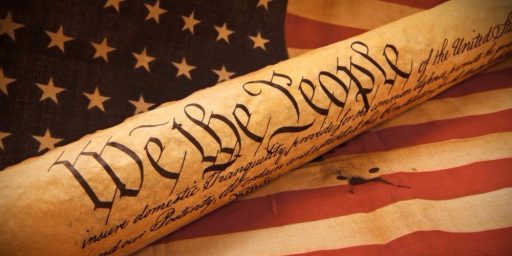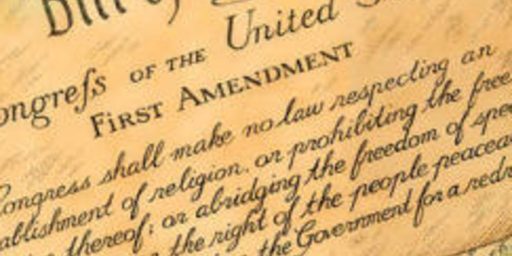Two Constitutions: Republican and Democrat
Brett Marston?, guesting at PoliBlog while the Taylors vacation, links an academic paper on the views the Republicans and Democrats have of the Constitution.
The Republicans have frozen their constitution at Brown. It is the bygone world of small-town America revisited with the decided improvement that racial discrimination is prohibited. Religion can be a part of the schools; abortion may be criminalized; and police practices are largely invisible to judicial scrutiny. Courts know their subordinate place and stay there, though activism may be required to get back to the right status quo.
By contrast the rights-oriented Democratic position requires a return to the Warren Court and a judiciary actively willing to place certain values into the Constitution because that is what right-thinking people would have in a good constitution. Democrats look to a Court with the immodesty of Antonin Scalia and the jurisprudence of William J. Brennan. The “Great Court” is then coupled with an unacknowledged hostility to elections. Whatever their rhetoric about facilitating voting and voters, Democrats are unwilling to let elections decide the federal or state policies on the issues discussed. (footnotes omitted)
While I think it’s a little more complicated than that–there’s the whole Strict Constructionist versus Textualist debate even among conservative Republican jurists, for example–it’s a good snapshot at what non-lawyer activists in both parties want.
Of the two stark visions above, I’d still prefer the former. Indeed, I prefer my Constitution fixed at the date of the last amendment, not the last Supreme Court edict.






I tend to agree with the quote…although I am not so sure I would place the cut-off at Brown – perhaps somewhere in the early 60s….what I find more interesting, and certainly true, is the Democrats issue with elcetions and elected officials other than themselves…perfect example would be the 200 election, in which elected officials (elction commisoners, state legislators, secretary of state) were “pushed aside” in favor of judges, which backfired when Supreme Court said basically, the law is the law and the courts can’t ignore it or rewrite to suit the situation….of course, this was “stealing” the election, since it meant votes that were countable counted and those that were not were not….
From what I see, this isn’t right. the line should be drawn for the Democrats anywhere between 1933 and the 60’s; Dems like the New Deal Court, by and large, and Hugo Black (leading to the incorporation of the Bill of Rights into the 14th Amendment).
Republicans would like, to some degree, to turn the clock back to the 1920’s and 30’s, when the Court was filled by activist conservative judges, who struck down legislation designed to regulate, among other things, economic markets (e.g. minimum wage laws). That Court was as activist as the Warren court, but tilted to the other side.
The fact is that both sides want activist judges — each arguing about the bias. Speaking of Bush v. Gore, that was one of the most “activist” decisions of the past 100 years, and flew in the face of everything Scalia ever wrote about “States’ Rights” — or the Equal Protection clause, for that matter.